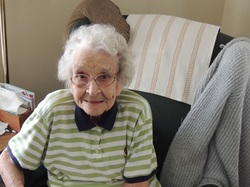 98 and going strong!
98 and going strong! Hilda and her family moved into this farm in 1917 when she was one year old and she grew up there with her parents and seven sisters. Imagine eight teenage girls sharing one bathroom with their folks. But, at least the bathroom was indoors. The girls shared three upstairs bedrooms and the parents had one downstairs. The farmhouse was an old one, not particularly well insulated against cold Ohio winters or sweaty summers.
She was one of the youngest in the family and she, like her sisters, pitched in to help keep up the farm. Daily chores got done. Period. They had eight horses and a few dairy cows and they raised corn, wheat, oats, and alfalfa. She became a teenager when the Great Depression hit – 1929.
The first question I asked was the secret to her liveliness at 98. “Que sera, sera,” Hilda replied without hesitation. Her alertness amazed me. For those of you not familiar with this song (sung by Doris Day in a 1956 movie), its lyrics reflect a person’s passage through life:
When I was just a little girl
I asked my mother
What will I be
Will I be pretty
Will I be rich
Here's what she said to me
Que sera, sera
Whatever will be, will be
The future's not ours to see
Que sera, sera
What will be, will be
The phrase, perhaps not grammatically correct in either Spanish, French, or Italian, is hundreds of years old and connotes a sense of acceptance of reality. Whatever happens in your life happens and you accept it and move on.
When the song came out, Hilda was in her 40s and raising her five children. She had her hands full but she must have been impressed by this song. Now, 50 years later, it’s still at the tip of her tongue. I found this fascinating because the song, an Oscar winner, exemplifies the Buddhist philosophy of living in the moment – not fretting about the past and not obsessed with the future. Just take what life gives you and make the best of it.
“What was it like, Hilda, growing up in the Depression?” I asked. She couldn’t think of anything unusual. People living on farms in the country kept up their gardens and livestock healthy, they didn’t drive expensive cars, and they lived within their means. For Hilda, life during the Depression was just like it was before the Depression. No big deal.
As I interviewed her, I watched her facial expressions to look for any signs of sarcasm or negativity. I didn’t see any. She didn’t complain about medical conditions or the cost of medicine. In fact, she didn’t complain at all. She told me that she had recently been using a walker to help her with balance since she fell a few months ago, though she didn’t break any bones. Her son arranged for two ladies to look after her. She still lives in her brick 1920s-era house.
Again I asked her about her life in the Depression. “Mom made our clothes, we all had chores, we walked to visit neighbors, and we wore our good clothes when we rode into town.” I asked her for a story. “We walked about a half mile down the road to our school house and had to walk over a small bridge with a metal railing. In all kinds of weather. Once my oldest sister Maxine kissed the bridge – in winter – and got her tongue stuck to the railing.”
When I wondered what happened, Hilda said, “I reckon she pulled it off.” So here’s a 98-year-old country lady with a sense of humor. I asked about her diet: “beans and cornbread.” What’s her favorite food: fried chicken. So you can live to 98 and eat fried foods? Hmmmm. Well, Hilda’s trim build shows that she doesn’t overeat, even though fried foods aren’t the recipe for a long life. I still agree with Satchel Paige: fried foods anger up the blood.
But life was not all fun and games. Hilda buried her parents and her sisters, all who lived into their 90s. But, worst of all, she’s had to attend funerals for two of her children, arguably one of the highest stressors we face in life. Yet she manages to be cheerful, alert, and full of zip.
She told me that they were holding a family reunion on Sunday – in her little town. “I’m going to buy 20 pounds of chicken,” she proclaimed proudly, “but at 39 cents a pound it won’t set me back too bad.” When I called her today to ask permission to publish this blurb and her photo, she told me that 130 showed up at the reunion and that they had plenty of fried food, cake, and ice cream.
My Highland County friend who took me barn hunting that day told me that her own mother, who almost reached 100, had an attitude similar to Hilda’s. While we drove home, she pointed out a 100-year-old lady who was pulling weeds in her yard. Maybe Highland County has the secret to a long, happy and useful life. Que sera, sera.

 RSS Feed
RSS Feed